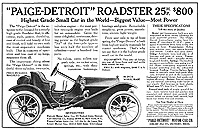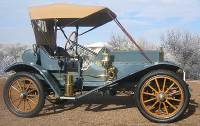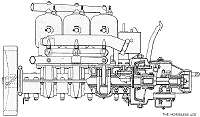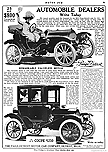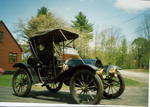| < Introduction | 1911 > |
1910 First "Paige-Detroit"
| Model: | 1 |
| Cylinders: | 3 |
| Horsepower SAE: | 25 |
| Wheelbase: | 90 |
The first Paige-Detroit, $800 FOB Detroit, was a light, open two-seater roadster named Challenger. A picture of this first car appeared in the December 29, 1909, issue of The Horseless Age as part of an extensive photo listing of cars to be shown at the 1910 national shows that opened on New Year's Day. The following week The Horseless Age carried a descriptive article, and an ad for this new model appeared in the January 8, 1910, issue of The Saturday Evening Post.
The car had a 90 inch wheelbase, 56 inch tread, 32 inch wheels fitted with 3 inch tires, semi-elliptic springs at the front, a full elliptic spring mounted crosswise at the rear, and a cylindrical gas tank at the rear. Each car came equipped with oil lamps on either side, one on the rear, a bulb horn, and a tool kit. All bodies were "ironed for tops", but the top itself was extra. Standard enamel colors were a dark blue body and cream yellow running gear, all tastefully striped, according to The Horseless Age.
The unique feature of this initial offering was its three-cylinder, two-cycle engine. The automobile world was quite familiar then with single cylinder motors, as well as two-, four-, and six-cylinder versions, but a three-cylinder engine was quite rare, and a three-cylinder, two-cycle engine was even rarer. Such motors were in widespread use for marine purposes, but one in an automobile was a novelty. The company felt that this type of motor was superior in a number of ways to the more common four-cycle motors "in smoothness of operation and flexibility, and that it is much more desirable, since it has no small parts to get out of adjustment." This motor, with the cylinders cast separately, produced 25 HP, and it was claimed to provide the same power as any of the high grade six-cylinder automobiles then available and to provide it with fewer parts.
The little roadster was an instant success. As 1910 wore on, a compact two-passenger coupe body was developed for the same chassis. A buyer could order both roadster and coupe bodies and switch between them for year-round motoring.
With production underway Harry Jewett began to learn more about cars. In the spring of 1910 his assessment of his Paige-Detroit auto was not good. Fred Paige left the company, and Jewett installed himself as the president. He hired a new general manager, shut down the assembly line, and commenced to reorganize the engineering department. The Company had sold 800 autos in its first year.
In writing many years later about this experience Fred Paige stated simply "I acted as President and General Manager for a time and then moved to New York and retired from business." He eventually established the Paige & Jones Chemical Company, specializing in water softening treatment. Paige sold his interest in this company in 1930 and retired to Los Angeles, where in died in 1935 at age 71 after a short illness.
|
Horsepower SAE The formula to calculate horsepower was to multiply the square of the cylinder diameter in inches by the number of cylinders and to divide the product by the constant 2.5. This formula was based on a piston speed of 1,000 feet per minute, average pressure of 90 pounds per square inch and a mechanical efficiency of 75%. It was considered to result in a fair, conservative rating that would be useful in comparing one car with another. The calculation was adopted by the Society of Automobile Engineers (Society of Automotive Engineers, SAE, after 1916), by the the Association of Licensed Automotive Manufacturers (ALAM) and by the National Automobile Chamber of Commerce (NACC). Other methods for calculating horsepower included indicated horsepower (IHP) and brake horsepower (BHP). IHP measured the power applied to the piston of the engine by the explosion and expansion of the gases. BHP was the power delivered by the engine to the machinery it was driving. The ratio of BHP to IHP was a measure of efficiency. With the evolution of automobile engines BHP became a more meaningful measure of power than the original SAE formula. |
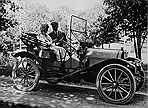 |
 |
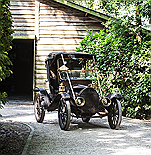 |
| 1910 Challenger (Internet image, uncredited) | Henry Ford Museum | Henry Ford Museum |
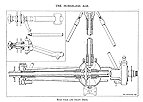 |
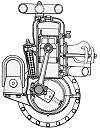 |
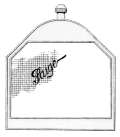 |
| Rear Axle & Shaft Drive | Motor | Radiator |
| The Horseless Age, Jan. 5, 1910 | ||
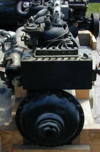 |
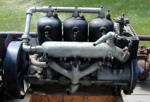 |
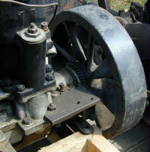 |
 |
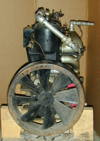 |
| Paige-Detroit marine engine (William Schaller photos) | ||||
Elsewhere in 1910:
- Henry Ford, after building 12,000 cars in two years at his Piquette Ave. factory in Detroit, opens a production plant in the nearby village of Highland Park to continue producing his Model T.
- William Durant founds Chevrolet.
| < Intro | 1911 > |
